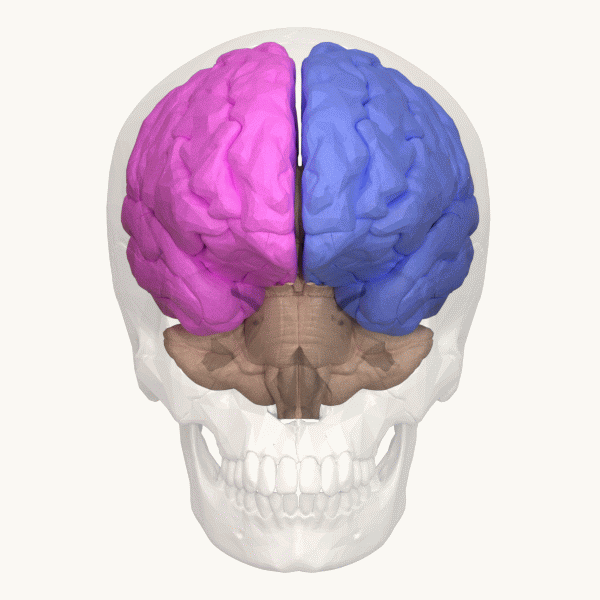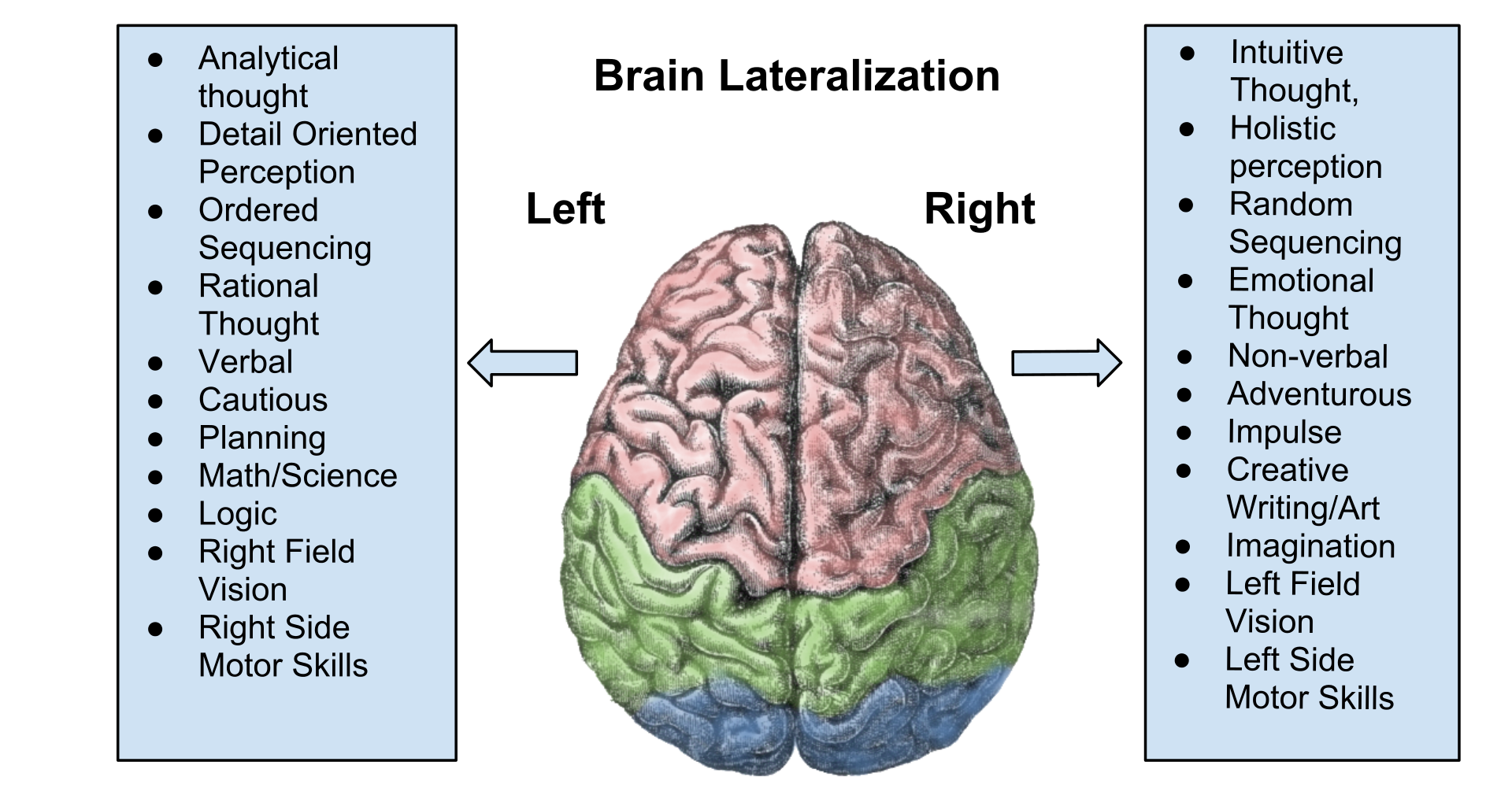|
Lateralization
The lateralization of brain function (or hemispheric dominance/ lateralization) is the tendency for some neural functions or cognitive processes to be specialized to one side of the brain or the other. The median longitudinal fissure separates the human brain into two distinct cerebral hemispheres connected by the corpus callosum. Both hemispheres exhibit brain asymmetries in both structure and neuronal network composition associated with specialized function. Lateralization of brain structures has been studied using both healthy and split-brain patients. However, there are numerous counterexamples to each generalization and each human's brain develops differently, leading to unique lateralization in individuals. This is different from specialization, as lateralization refers only to the function of one structure divided between two hemispheres. Specialization is much easier to observe as a trend, since it has a stronger anthropological history. The best example of an establi ... [...More Info...] [...Related Items...] OR: [Wikipedia] [Google] [Baidu] |
Brain Asymmetry
In human neuroanatomy, brain asymmetry can refer to at least two quite distinct findings: * Neuroanatomical differences between the left and right sides of the brain * Lateralized functional differences: lateralization of brain function Neuroanatomical differences themselves exist on different scales, from neuronal densities, to the size of regions such as the planum temporale, to—at the largest scale—the torsion or "wind" in the human brain, reflected shape of the skull, which reflects a backward (posterior) protrusion of the left occipital bone and a forward (anterior) protrusion of the right frontal bone. In addition to gross size differences, both neurochemical and structural differences have been found between the hemispheres. Asymmetries appear in the spacing of cortical columns, as well as dendritic structure and complexity. Larger cell sizes are also found in layer III of Broca's area. The human brain has an overall leftward posterior and rightward anterior as ... [...More Info...] [...Related Items...] OR: [Wikipedia] [Google] [Baidu] |
Cerebral Hemisphere
The vertebrate cerebrum (brain) is formed by two cerebral hemispheres that are separated by a groove, the longitudinal fissure. The brain can thus be described as being divided into left and right cerebral hemispheres. Each of these hemispheres has an outer layer of grey matter, the cerebral cortex, that is supported by an inner layer of white matter. In eutherian (placental) mammals, the hemispheres are linked by the corpus callosum, a very large bundle of axon, nerve fibers. Smaller commissures, including the anterior commissure, the posterior commissure and the fornix (neuroanatomy), fornix, also join the hemispheres and these are also present in other vertebrates. These commissures transfer information between the two hemispheres to coordinate localized functions. There are three known poles of the cerebral hemispheres: the ''occipital lobe, occipital pole'', the ''frontal lobe, frontal pole'', and the ''temporal lobe, temporal pole''. The central sulcus is a prominent fissu ... [...More Info...] [...Related Items...] OR: [Wikipedia] [Google] [Baidu] |
Face Perception
Facial perception is an individual's understanding and interpretation of the face. Here, perception implies the presence of consciousness and hence excludes automated facial recognition systems. Although facial recognition is found in other species, this article focuses on facial perception in humans. The perception of facial features is an important part of social cognition. Information gathered from the face helps people understand each other's Identity (social science), identity, what they are thinking and feeling, anticipate their actions, Emotion recognition, recognize their emotions, build connections, and communicate through body language. Developing facial recognition is a necessary building block for complex societal constructs. Being able to perceive identity, mood, age, sex, and race lets people mold the way we interact with one another, and understand our immediate surroundings. Though facial perception is mainly considered to stem from visual intake, studies have s ... [...More Info...] [...Related Items...] OR: [Wikipedia] [Google] [Baidu] |
Human Brain
The human brain is the central organ (anatomy), organ of the nervous system, and with the spinal cord, comprises the central nervous system. It consists of the cerebrum, the brainstem and the cerebellum. The brain controls most of the activities of the human body, body, processing, integrating, and coordinating the information it receives from the sensory nervous system. The brain integrates sensory information and coordinates instructions sent to the rest of the body. The cerebrum, the largest part of the human brain, consists of two cerebral hemispheres. Each hemisphere has an inner core composed of white matter, and an outer surface – the cerebral cortex – composed of grey matter. The cortex has an outer layer, the neocortex, and an inner allocortex. The neocortex is made up of six Cerebral cortex#Layers of neocortex, neuronal layers, while the allocortex has three or four. Each hemisphere is divided into four lobes of the brain, lobes – the frontal lobe, frontal, pa ... [...More Info...] [...Related Items...] OR: [Wikipedia] [Google] [Baidu] |
Corpus Callosum
The corpus callosum (Latin for "tough body"), also callosal commissure, is a wide, thick nerve tract, consisting of a flat bundle of commissural fibers, beneath the cerebral cortex in the brain. The corpus callosum is only found in placental mammals. It spans part of the longitudinal fissure, connecting the left and right cerebral hemispheres, enabling communication between them. It is the largest white matter structure in the human brain, about in length and consisting of 200–300 million axonal projections. A number of separate nerve tracts, classed as subregions of the corpus callosum, connect different parts of the hemispheres. The main ones are known as the genu, the rostrum, the trunk or body, and the splenium. Structure The corpus callosum forms the floor of the longitudinal fissure that separates the two cerebral hemispheres. Part of the corpus callosum forms the roof of the lateral ventricles. The corpus callosum has four main parts – individual nerv ... [...More Info...] [...Related Items...] OR: [Wikipedia] [Google] [Baidu] |
Split-brain
Split-brain or callosal syndrome is a type of disconnection syndrome when the corpus callosum connecting the two hemispheres of the brain is severed to some degree. It is an association of symptoms produced by disruption of, or interference with, the connection between the hemispheres of the brain. The surgical operation to produce this condition ( corpus callosotomy) involves transection of the corpus callosum, and is usually a last resort to treat refractory epilepsy. Initially, partial callosotomies are performed; if this operation does not succeed, a complete callosotomy is performed to mitigate the risk of accidental physical injury by reducing the severity and violence of epileptic seizures. Before using callosotomies, epilepsy is instead treated through pharmaceutical means. After surgery, neuropsychological assessments are often performed. After the right and left brain are separated, each hemisphere will have its own separate perception, concepts, and impulses to act ... [...More Info...] [...Related Items...] OR: [Wikipedia] [Google] [Baidu] |
Contralateral Brain
The contralateral organization of the forebrain (Latin: contra‚ against; latus‚ side; lateral‚ sided) is the property that the Cerebral hemisphere, hemispheres of the cerebrum and the thalamus represent mainly the contralateral side of the body. Consequently, the left side of the forebrain mostly represents the right side of the body, and the right side of the brain primarily represents the left side of the body. The contralateral organization involves both executive and sensory functions (e.g., a left-sided brain lesion may cause a right-sided hemiplegia). The contralateral organization is only present in vertebrates. A number of theories have been put forward to explain this phenomenon, but none are generally accepted. These include, among others, Santiago Ramón y Cajal, Cajal's #Visual map theory, visual map theory, different topological approaches, the #Comparing inversion, somatic twist and axial twist, somatic twist theory and the axial twist theory. Anatomy Ana ... [...More Info...] [...Related Items...] OR: [Wikipedia] [Google] [Baidu] |
Emotional Prosody
Emotional prosody or affective prosody is the various paralinguistic aspects of language use that convey emotion. It includes an individual's tone of voice in speech that is conveyed through changes in pitch, loudness, timbre, speech rate, and pauses. It can be isolated from semantic information, and interacts with verbal content (e.g. sarcasm). Emotional prosody in speech is perceived or decoded slightly worse than facial expressions but accuracy varies with emotions. Anger and sadness are perceived most easily, followed by fear and happiness, with disgust being the most poorly perceived. Production of vocal emotion Studies have found that some emotions, such as fear, joy and anger, are portrayed at a higher frequency than emotions such as sadness. *Anger: Anger can be divided into two types: "anger" and "hot anger". In comparison to neutral speech, anger is produced with a lower pitch, higher intensity, more energy (500 Hz) across the vocalization, higher first form ... [...More Info...] [...Related Items...] OR: [Wikipedia] [Google] [Baidu] |
Cerebral Hemisphere - Animation
Cerebral may refer to: * Of or relating to the brain * Cerebrum, the largest and uppermost part of the brain * Cerebral cortex, the outer layer of the cerebrum * Retroflex consonant, also referred to as a cerebral consonant, a type of consonant sound used in some languages * Intellectual, rather than emotional See also * {{Disambiguation ... [...More Info...] [...Related Items...] OR: [Wikipedia] [Google] [Baidu] |
Grammar
In linguistics, grammar is the set of rules for how a natural language is structured, as demonstrated by its speakers or writers. Grammar rules may concern the use of clauses, phrases, and words. The term may also refer to the study of such rules, a subject that includes phonology, morphology (linguistics), morphology, and syntax, together with phonetics, semantics, and pragmatics. There are, broadly speaking, two different ways to study grammar: traditional grammar and #Theoretical frameworks, theoretical grammar. Fluency in a particular language variety involves a speaker internalizing these rules, many or most of which are language acquisition, acquired by observing other speakers, as opposed to intentional study or language teaching, instruction. Much of this internalization occurs during early childhood; learning a language later in life usually involves more direct instruction. The term ''grammar'' can also describe the linguistic behaviour of groups of speakers and writer ... [...More Info...] [...Related Items...] OR: [Wikipedia] [Google] [Baidu] |
Word Superiority Effect
In cognitive psychology, the word superiority effect (WSE) refers to the phenomenon that people have better recognition of letters presented within words as compared to isolated letters and to letters presented within nonword (orthographically illegal, unpronounceable letter array) strings. Studies have also found a WSE when letter identification within words is compared to letter identification within pseudowords (e.g. "WOSK") and pseudohomophones (e.g. "WERK"). The effect was first described by Cattell (1886), and important contributions came from Reicher (1969) and Wheeler (1970). Cattell first wrote, "I find it takes about twice as long to read...words which have no connexion as words which make sentences, and letters which have no connexions as letters which make words. When the words make sentences and the letters words, not only do the processes of seeing and naming overlap, but by one mental effort the subject can recognize a whole group of words or letters". G. Reicher ... [...More Info...] [...Related Items...] OR: [Wikipedia] [Google] [Baidu] |
Antonyms
In lexical semantics, opposites are words lying in an inherently incompatible binary relationship. For example, something that is ''even'' entails that it is not ''odd''. It is referred to as a 'binary' relationship because there are two members in a set of opposites. The relationship between opposites is known as opposition. A member of a pair of opposites can generally be determined by the question: "What is the opposite of ''X''" The term antonym (and the related antonymy) is commonly taken to be synonymous with opposite, but antonym also has other more restricted meanings. Graded (or gradable) antonyms are word pairs whose meanings are opposite and which lie on a continuous spectrum (''hot'', ''cold''). Complementary antonyms are word pairs whose meanings are opposite but whose meanings do not lie on a continuous spectrum (''push'', ''pull''). Relational antonyms are word pairs where opposite makes sense only in the context of the relationship between the two meanings (''teache ... [...More Info...] [...Related Items...] OR: [Wikipedia] [Google] [Baidu] |






